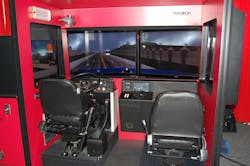There’s been a move in several quarters of the trucking industry to implement more “virtual” forms of driver training – everything from online safety courses to full driver simulator systems – not just as a way to reduce the costs of training but also reduce the amount of time required to conduct such training as well.
“Safety [departments] are in a valuable, but difficult position,” Bob Davis, president of Virtual Driver Interactive, explained to Fleet Owner. “On one hand they are responsible for the safety of the employees and crash related costs but they are not usually the budget center owners of those they train – meaning, the time they take and the costs to train the drivers are continually concerns for the line of business or business unit managers.”
He added that scheduling an employee to be away from their job for an 8 hour day of training not only means they aren’t doing their regular job but also making a fully loaded rate of $35 an hour equates to costs of $280 of labor expense while training.
“When you add in ‘train the trainer’ hourly wages, or classroom costs and the cost of the ‘program’ it means per person costs of $500 or more,” Davis noted. “The cost of training time is often more expensive than the cost of the training itself.”
Schneider National is one carrier that’s used simulators since 2005. In an article published last year, the company noted that technology helped in part to reduce the carrier’s crash rates by 32% when compared to its use of “traditional” training methods that relies exclusively on classroom work and in-cab instruction.
Based on its multi-year of experience with the technology, Schneider determined that one hour of simulator time equals about four hours of behind-the-wheel training in a truck. With one hour of in-truck training consuming an average of 2.5 gallons of diesel, Schneider said it can cut training costs some $40 per hour alone due to fuel savings (with diesel costing $4 per gallon) by using simulators to help train new drivers as well as re-certify the skills of veteran operators.
But simulators and other types of “virtual” training are not limited to over-the-road carriers alone. Virtual Driver’s Davis notes that a variety of different companies that rely on vehicles to conduct their business use his firm’s technology to train drivers, including Public Service Electric and Gas Company (PSE&G) and Canada’s Saskatchewan Government Insurance (SGI).
Other types of fleets – such as municipal fire departments – are experimenting with simulators and virtual training aids to help improve driver skills for rookies and veterans alike.
Davis points out that another twist that complicates “traditional” driver training methods further is trying to teach an experienced adult about driver safety, as it is very hard to gain and then maintain their attention.
“If the teaching method is ‘telling,’ which is the case with all web-based and classroom training, then having the driver do anything other than answer questions is not possible,” he says. “Compounding the issue is that many times this training is ‘refresher training’ so everyone knows going in that they’ve already been told this before – how is that exciting?”
That’s why Davis believes “virtual training” especially when coupled to interactive driving simulations are now being more widely implemented – especially by larger companies – as such technology can help: reducing crashes overall (especially those involving distractions and texting); reduce the overall cost of the training delivery process; and improving the training experience by providing not just “interactivity” but a targeted focus as well.
“And as a virtual training program grows, it can be adapted for specific crash issues,” Davis said. “For example: do you have frequent low speed crashes backing out of customer driveways? Do you have multi overcorrection crashes with a bucket truck on icy roads? Then let’s take those specific environments, situations and losses and fine-tune your training.”
That’s why interactive training can be more effective training, he believes, because it refines and better targets the “experience of learning” when it comes to operating vehicles safely.
About the Author
Sean Kilcarr
Editor in Chief
Sean Kilcarr is a former longtime FleetOwner senior editor who wrote for the publication from 2000 to 2018. He served as editor-in-chief from 2017 to 2018.
